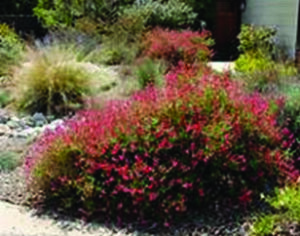By Debbie Roland and
Emmy Ulmschneider
Master Gardeners
When we discussed plants that could replace boxwoods and other hedge type plants that were hit by the freeze, we narrowed it down to six. Following are the final three.
Turk’s Cap: Turk’s Cap (Malvaviscus arboreus) is one shrub that grows fast, reaching 6’ x 4’ in the sun but 2’ to 3’ in the shade. It tolerates the hot West Texas sun and cold down to 20 degrees. Turk’s Cap will grow in poor soil and drought conditions but will handle lots of water as well.
Native to Texas and the southeastern US, this is an adaptable plant. Its dark red-orange, hibiscus like blooms will adorn your yard from mid-summer until the first freeze. There are also white and pink cultivars. One of its common names, Turks Cap, refers to the flower shape. The nectar of the red blooms is a great draw for butterflies, hummingbirds, moths and other nectaring insects. The blooms soon give way to an edible fruit that birds and small mammals relish.
This plant is deciduous in our area. Cut it back after the winter to keep the plant bushy and attractive.

Fragrant Sumac: Fragrant Sumac (Rhus aromatica) goes by a variety of common names. Shiny green leaves are late to bloom in spring but maintain their growth during tough conditions. It can grow to 6’ x 6’, prefers full sun but will tolerate part shade. Its water needs are dry to moderate. In early spring, the small yellow flowers appear before the leaves and are a nectar source for butterflies and bees. The flowers give way to orange-red berries that are loved by birds and small mammals. The leaves produce a citrusy odor (thus the name) when crushed. In fall, the glossy green, trifoliate leaves turn an attractive variety of red, orange, purple, and yellow hues. Left alone, fragrant sumac can be grown as a small shrub. It will sucker from the roots and over time can from a thicket or an informal hedge to provide visual screening. There are low-growing cultivars, growing up to 18 inches, that are outstanding as a wide spreading groundcover.
Autumn Sage: (Salvia Greggii): This Texas endemic has grown beyond our borders and into a popular southwestern landscape plant. Go to any nursery and you can find the cultivars in hues of white, rose, red, purple, blue and two colors. In the wild, the color varies. This perennial plant is grown as a small ornamental shrub whose tubular flowers attract pollinators and are a hummingbird magnet. It requires full sun with well-drained soil.
Salvia Greggii has a high heat and cold tolerance and is nearly evergreen which is perfect for a low, flowering hedge. It should be trimmed during the growing season to keep it from getting leggy. If left unpruned, it can reach up to five feet. Regular tip pruning will promote blooming.
For more information, call the AgriLife office at 498-4071 in Odessa or at 686-4700 in Midland or visit aggie-horticulture.tamu.edu or westtexasgardening.org.




